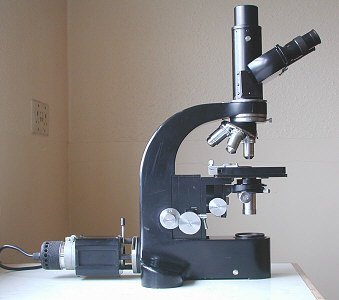 |
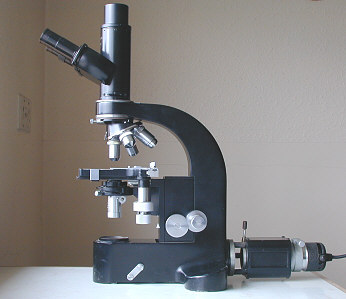 |
| THE LEITZ DIALUX 1 The poor man's Ortholux? A brief personal appraisal By Paul James |
Mention "Dialux" to microscopists and in all probability they would envisage one of the relatively recent versions of Leitz Wetzlar's stands. This isn't altogether surprising as the original Dialux was quite different to the modern trend of angular stands that Leitz came to design in later models. The original Dialux 1, the subject of this appraisal, has design roots akin to the Ortholux 1 which it resembles in many ways though it is somewhat smaller. The Dialux 1 has often been incorrectly identified as the Ortholux 1, the latter originating from 1936.... if I remember correctly. This particular example of the Dialux 1 was issued circa 1958.
THE STAND
 |
 |
The arched limb and trinocular upper works give this stand a characteristic look which is shared with other models of the 1950's era such as the Ortholux and Metallux. They are based on a 'T' profile foot which gives great stability from a given quantity of casting, though the Dialux's limb is of less substantial section ( though I must add here that the thicker upper limb of the Ortholux also serves to house a vertical illumination tunnel which the Dialux does not have and therefore less need of extra rigidity in this region).
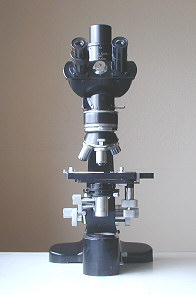 |
The side 'feet' of the Dialux have sloping upper faces so that the hands and fingers can manipulate the controls easily and comfortably. The centre foot is necessarily deep to accommodate the illumination beam and a manual lever is incorporated there to remove or add a supplementary lens for lighting effects. A clear window allows the illumination to feed the condenser from the internal 45 deg mirror in centre foot, which is rimmed nicely to receive filters.
Focussing is provided with motion from the coarse and fine control knobs through to the stage in both cases: the limb being static and a continuous fusion of the foot. Thus the focus 'block' bonds with both foot and limb to add rigidity to the stand. In action these superbly smooth controls were obviously a result of top class design and engineering, with nicely facilitated ratio's too. There is a freedom of motion combined with superb stability in the operation of the fine focus which really appeals and makes for reliable oil immersion usage.
The upper limb receiving the bino/trino/ocular head is of the circle bayonet type and is very positive and firmly holds the former in place with a spring loaded locking device.
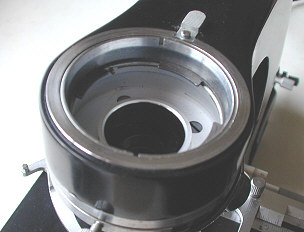 |
STAGE
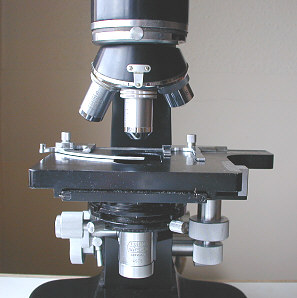 |
Modest but very adequate is how I would describe the stage's platform, whose horizontal controls are of the coaxial / vertical form, giving a very smooth motion commensurate with the stand's pedigree, with a scope of movement easily covering the entire surface of a 3x1 slide (Not all quality microscope stands sport this feature). Note the objective turret which turns the batch of optics away from the observer allowing more convenient access to the stage and therefore less chance too of accidental contact twixt slide and objective lenses.
TRINOCULAR/BINOHEAD
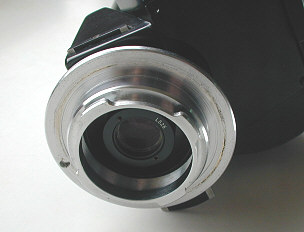 |
One of the virtues of Leitz's trinocular heads like this example, is that it is an either all or nothing configuration. Thus all the light passes through to the eyes or by sliding the prism assembly away, all the unimpeded light passes straight up to the camera port. Whilst offering maximum fidelity from a photograph it does restrict imaging to static specimens, though a viewing/focusing right angle eyepiece can restore some spontaneity to capturing the living forms.
Both interocular and independent focussing facilities are present for the eyepieces, and also this particular example came with a 160mm tube length insert which by simple washer spacing can be used for both 160/170mm TL objectives, or it can be nipped in position temporarily.
SUBSTAGE
This area is commendably bereft of fussiness with plenty of space for substage optics using the Leitz 47mm dovetail fork fitting. Each Leitz dovetailed condenser has an inbuilt integral centering facility which allows the removal and replacement of other substage optics already 'pre' centred. Together with an easily and speedily accessed fork dovetail makes for very rapid illumination changes without having to recentre each, or at least reducing the time taken to do so. In photomicrography this can be very important in capturing the living forms whilst at the same time optimising lighting. The Zeiss Zernicke substage condensers have the edge here in speed and convenience having the individual lighting options by turning the disc from either BF, DF, Phase contrast or COL etc.. Leitz's Heine condenser which this stand came with, is their answer to the problem of substage manipulation and convenience..........which is rather good too.
LAMPHOUSE
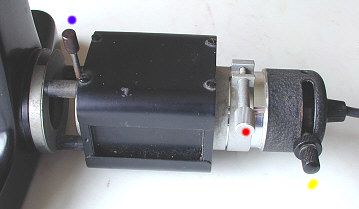 |
One of the virtues of more modern designs is that the internal folded illumination system can reduce the 'foot' area of the stand of which the Wild M20 is an example. The Dialux 1 here has a more straightforward design where the light passes through the foot of the stand from back to front and upwards from a 45 deg mirror held in the front of the centre foot. I believe it to be a very good and more easily collimated design but which comes at the cost of an increase in bench top space requirement. I'd imagine most amateurs like myself would find this no particular problem which has at least the merit of being able to be adapted to take other light sources should the original become scarce. The original 12 volt bulb failed and so I have mounted a halogen alternative in the original socket which works extremely well.
Adjustments are very easily implemented using either controls for adjusting each of the parameters required for Kohler illumination. Filament centering : Lamp focus/lamp condenser : Focus for substage Condenser iris.
OPTICS
The optical quality of Leitz microscope components is well known and needs no further comments, save to mention that their 170mm offerings of objectives from the mid 20th century represent extremely good value for money in the used markets.
ODDS AND ENDS
Even the most revered of stands can have minor flaws and the Dialux 1 is no exception: I find the coarse focus lock which is illustrated below to be uncomfortably close to the substage racking knob, which can easily and often bring about the painful trapping of a finger tip between them !
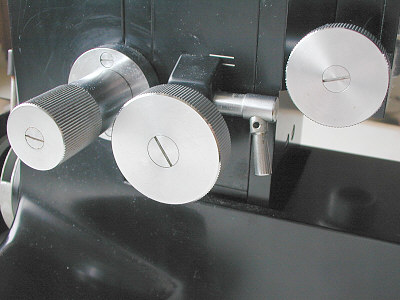 |
The travel of the coarse focus is less than many other stands and may be a problem for those wishing to use other makers objectives. A very minor issue possibly with viewing position: The Dialux 1 can only be used with the observer at the front because of the protuberance of the lamphouse.
CONCLUSIONS
This is a very good stand and amply rigid enough for the vast majority of uses. It has been called the poor man's Ortholux which is a deceptive term and one I believe to be unwarranted. Yes of course the Ortholux is a larger and somewhat more rigid stand, but any potential buyer of the Dialux 1 need not trouble themselves on this account unless they have very stringent, high power work to carry out. If vertical illumination is desirable too then the Dialux 1 will not be a consideration. The difference in prices will be fairly substantial: The Dialux 1 can be picked up for a fraction of that asked for the Ortholux.
Other than any minor misgivings, this unusually elegant design has proved to be a little gem.
| All comments welcome by the author Paul James |
Editor's note: Paul is reviewing
his internet access as at Jan 25th 2006.
Feedback can be sent via the email
link above to the Editor which will be forwarded.
Microscopy
UK Front Page
Micscape
Magazine
Article
Library
Please report any Web problems or offer general comments to the Micscape Editor.
Micscape is the on-line monthly magazine of the Microscopy
UK web
site at Microscopy-UK